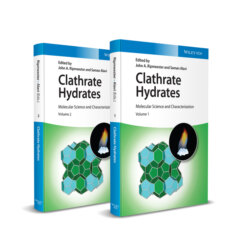Читать книгу Clathrate Hydrates - Группа авторов - Страница 29
2.8 Clathrate Hydrates in Engineering
ОглавлениеIn contrast to the largely European efforts in developing clathrate hydrate science, the early North American hydrate experiences fell much more along practical lines. E. Hammerschmidt (see Figure 2.8), an engineer at Texoma Energy, read Schröder's book1 and review article, and in 1933, this led him to the realization that it was gas hydrates (and not ice) that formed plugs in gas pipelines, thus causing flow problems [96]. This led to the phase equilibrium studies of natural gas components and water by W.M. Deaton and E.M. Frost (US Bureau of Mines) [97], Donald Katz (University of Michigan), Riki Kobayashi (Rice University), and coworkers. These important advances in the engineering and thermodynamics of gas hydrates, particularly for species in natural gas, are covered admirably in Dendy Sloan and Carolyn Koh's book on Clathrate Hydrates of Natural Gases [98]. This work resulted in general procedures for the prediction of solid hydrate formation under engineering conditions, usually based on gas gravity, and recipes for their prevention. The state of the art of this approach to hydrate prediction and prevention can be found, e.g. in the Handbook of Natural Gas Engineering (1959) [99]. This work would only develop along more knowledge‐based lines once the hydrate crystal structures and a theoretical description in the form of the “solid solution” theory became available in the late 1950s. Further development took place in describing guest–host interactions e.g. the work of McKoy and Sinanoglu on the use of the Kihara potential in the solid solution theory as an alternative to the Lennard‐Jones 12–6 potential [100]. The Kihara potential is similar to the Lennard‐Jones potential but considers molecules to have a hard, impenetrable core at the center. The modeling of phase equilibria was advanced considerably by Parrish and Prausnitz [101] who introduced the Kihara potential into the van der Waals and Platteeuw model and developed a particularly useful form for the computation of hydrate phase equilibria and cage occupancies. The first molecular simulations on clathrate hydrates were performed in 1972 by Tester, Bivens, and Herrick who used canonical Monte Carlo simulations to explicitly calculate guest–water interaction terms in the cages for use in the van der Waals–Platteeuw theory, without using the approximate Kihara potential form [102]. These simulations were followed in 1982 by the work of John S. Tse and Donald Davidson who improved the intermolecular potential representations of the water–guest interactions in the Monte Carlo simulations [103]. The first molecular dynamics simulations on hydrate phases were performed shortly afterward on structural characterizations of methane hydrate by J.S. Tse et al. [104].
With a good understanding of the nature of clathrate hydrates in hand, impressive strides were made in both experimental and predictive work on the phase equilibria of hydrates. In the 1960s and 1970s, a new generation of hydrate researchers arose in the United States and Canada: Gerald D. Holder in Pittsburgh, E. Dendy Sloan Jr. at the Colorado School of Mines (CSM), Donald B. Robinson at the University of Alberta, Raj Bishnoi at the University of Calgary. Much of the emphasis of these researchers was to deal with flow assurance problems involving hydrates: hydrate inhibition, hydrate plug prevention, and decomposition. In many of the laboratories mentioned above, hydrates became a continuing research theme which in many cases still continues – sometimes again with a new generation of hydrate researchers.
Another stream of hydrate research emerged when the US Office of Saline Water started a number of projects on the desalination of sea water. Hydrates were seen as one route to producing fresh water, with some advantages over the straightforward freezing of salt water to exclude salt. Allan Barduhn (University of Syracuse) investigated a large number of potential hydrate formers as potential desalting agents, including a number of chlorofluorocarbons (CFCs). Although hydrate desalination went as far as the pilot plant stage in the 1960s, so far a viable technology has not been developed.
